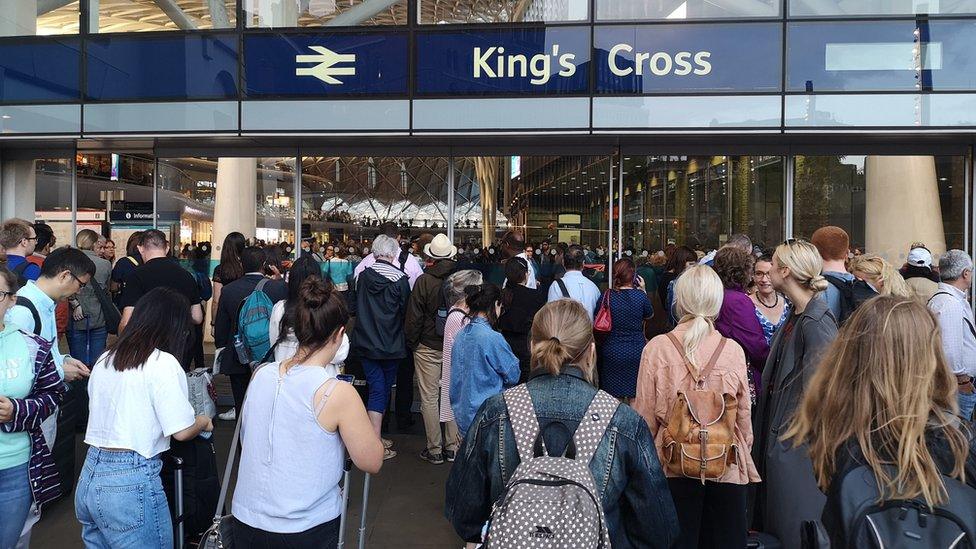Lightning strike 'partly to blame' for power cut
- Published
- comments
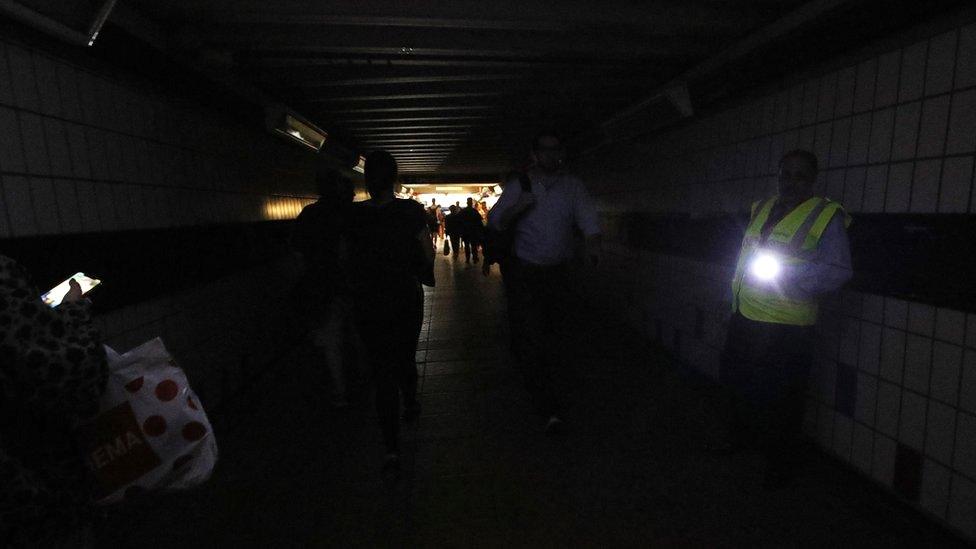
Train passengers were guided by torchlight at some stations during the power cut
A lightning strike and the sudden loss of two large electricity generators caused nearly a million people to lose power in England and Wales earlier this month, an interim report has found.
The National Grid outage affected homes, businesses and transport, and while power was restored quite quickly, disruption continued into the next day.
Regulator Ofgem has opened an investigation, external into National Grid and other companies involved.
That could lead to a financial penalty.
The investigation - what happens next?
Ofgem said its investigation "would try to establish what lessons can be drawn from the power cut to ensure that steps can be taken to further improve the resilience of Britain's energy network".
The regulator will also establish whether the companies involved breached their licence conditions.
Any punishment could involve a fine of 10% of the firms' turnover, an order to pay money to charities to help less well-off consumers, or to put cash into a fund to compensate those who lost out because of the power cuts.
Jonathan Brearley, Ofgem's executive director of systems and networks, said: "It's important that the industry takes all possible steps to prevent this happening again."
A National Grid spokesperson said: "It is now right and proper that the investigation looks at the system-wide performance of the energy networks on 9 August, in both the performance of the electricity system, and subsequent significant disruption to transports networks and critical infrastructure."


Why did the transport system go off the rails?
The power cut, which happened just before 17:00 BST on Friday 9 August, caused blackouts across the Midlands, the South East, South West, North West and North East of England, and Wales.
Thousands of homes lost power, people were stranded on trains and traffic lights stopped working
Power was restored by 17:40 BST, but problems on the rail network carried on over the weekend.
Two almost simultaneous unexpected power losses at Hornsea and Little Barford occurred independently of one another - but each associated with the lightning strike.
Power was not cut to the railway tracks but there were many travel problems, largely because about 60 Govia Thameslink trains were affected.
About half were able to restart when the power was restored to the correct frequency, but the rest required engineers to travel to restart them - and the resultant delay caused a backlog.
The affected models were made by Siemens and introduced in 2014.
The company said a software issue caused the problem and that it expected an update would prevent a recurrence.
In a statement, Siemens added it had "set up a Task Force together with our partners to investigate how the trains reacted to being exposed to this unusual power failure mode".
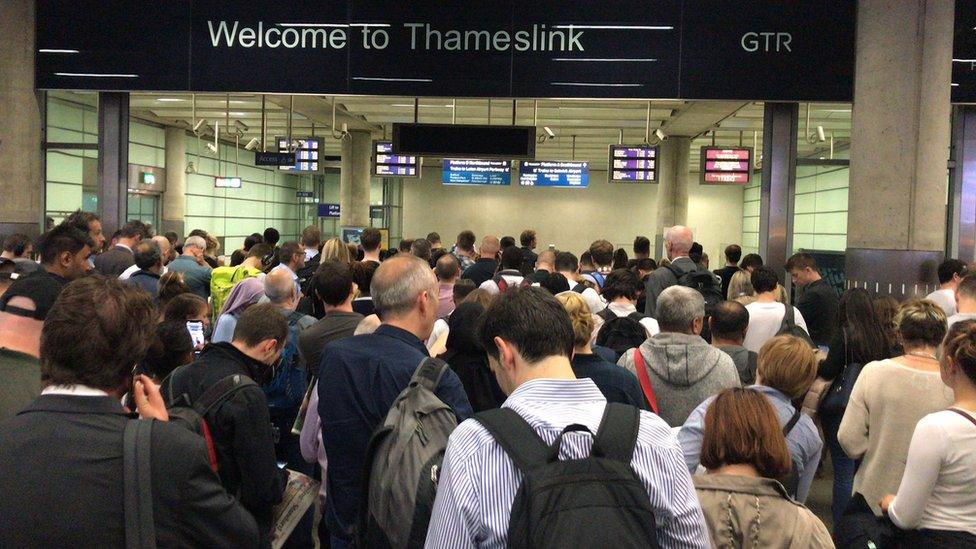
Passengers travelling on Thameslink were delayed
At the height of the Friday rush hour, all trains out of London King's Cross were suspended and remained so for most of the evening.
And by 21:00 BST, more than 1,000 passengers appeared to be stranded at the station, with London North Eastern Railway and National Rail advising customers not to travel for the rest of the day.
As well as Network Rail, other critical infrastructure affected on the day included London Underground's Victoria Line and Newcastle Airport.
Problems were also caused at Ipswich Hospital, where the back-up generator, which was supposed to supply power to outpatient areas, did not work after the outage because of a faulty battery.
This affected outpatients, X-rays, scans and pathology for nearly half an hour, but the hospital stressed no patients were put at risk.


Like the opening scene of an Agatha Christie novel, National Grid's preliminary investigation into the power cut 10 days ago is replete with clues and plausible villains, but lacks a final verdict on who or what cut the power.
There is a handy timeline of events - a lightning strike before 17:00 BST, the failure of two big power generators a few seconds later, and the subsequent loss of electricity across part of the country.
The authors though tread carefully when ascribing causality. The report says the power station failures were "associated" with the strike, but points out that such strikes are not uncommon, and would normally not lead to power stations going offline. It also says there were many other lightning hits on the same day, none of which caused a problem.
That gap at the heart of the report is what Ofgem will now investigate. It will want to know whether the lightning did cause the power station failures, and if so, how?
It will also explore whether there were other problems at the power stations that caused them to go offline, and whether the lightning strike is in reality a red herring.
There are other issues further down the chain to be resolved too. Once the power was cut, customers were automatically disconnected. Did that happen in the right order, or should critical users, including hospitals and power supplies for transport, be the last to be unplugged?
The answers could make uncomfortable reading for National Grid and the other companies involved in the power cut.

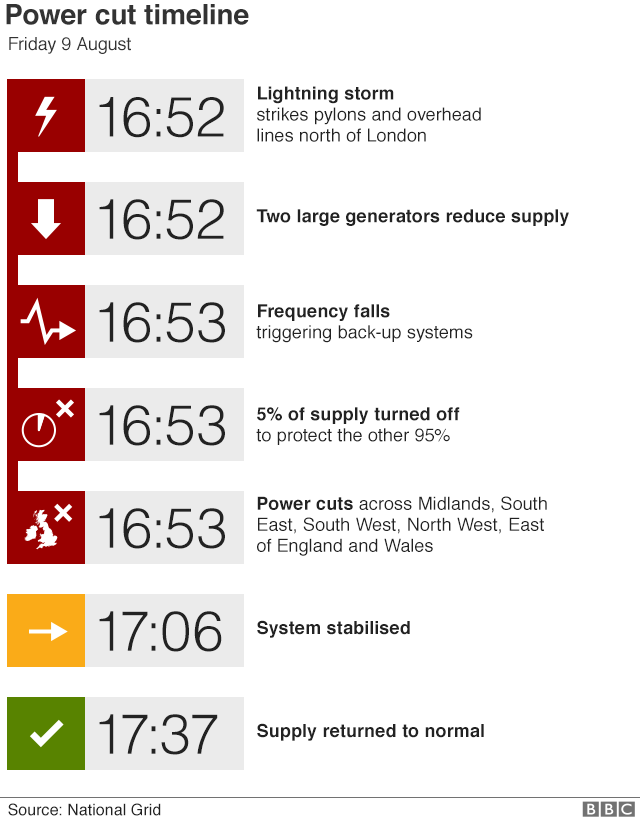

Will priorities be changed?
Sir John Armitt, chairman of the National Infrastructure Commission, told the BBC's Today programme the incident raised plenty of questions.
"What are the most critical elements of our infrastructure across this country and which elements do you turn off first?" he said.
"Have we got that order of priority right? And so why was it the railways went down as opposed to those of us living at home not losing some of our electricity?"
Sir John added: "The important thing is this a great case study in a way. It is a very unfortunate one, a lot of people were impacted by it, but it is something which everyone involved can learn from."
Which firms are being scrutinised?
Ofgem is to investigate National Grid ESO, National Grid Electricity Transmission, 12 distribution network operators in England and Wales, as well as generators RWE Generation (Little Barford Power station) and Orsted (Hornsea) in relation to the power cut.
The distribution companies are part of six network groups: Electricity North West Limited, Northern Powergrid, Scottish and Southern Energy, ScottishPower Energy Networks, UK Power Networks and Western Power Distribution.
The National Grid has to publish a final, technical report by 6 September and any Ofgem enforcement action will follow after that.
- Published10 August 2019

- Published10 August 2019
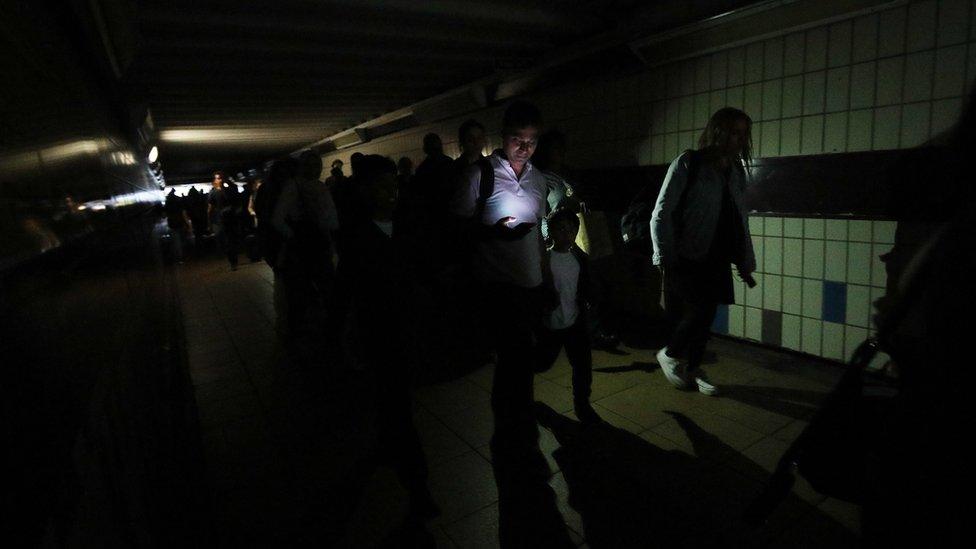
- Published10 August 2019
